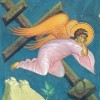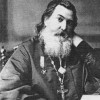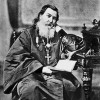Thus the funeral service has been completed. We chanted burial hymns; we raised our hearts to heaven and there sought a solution to the perplexities of the mind: how was it, in the words of the Church’s hymnography, that the Uncontainable was held fast by grave and seals? The Church now turns our attention to the face of the Dead One as He rests in His grave and here, at the utmost degree of His kenosis, under this cover of death, it shows in His suffering on the Cross and death the marvelous depth of His voluntary Divine self-emptying (Ode 4, irmos). This Dead One enclosed in an underground tomb is that supreme Lord Who once hid the pursuing tyrant in the waves of the sea and was afterwards glorified by them with triumphant songs. The Church invites us to look at this grave with awe and reverence as at the ineffable wonder (Ode 7, irmos). The Almighty God, Who showed countless miracles, is laid in the tomb, a lifeless corpse, for the salvation of us (Ode 7, irmos). The Church turns all our attention to that great event that amazed and made heaven tremble and shook the foundations of the earth when He Who dwells in the highest is numbered among the dead, and welcomed in a little tomb (Ode 8, irmos).
It is in consideration of this that the Church calls this Saturday “Great”. It gives our mourning a calm and peaceful expression. Here, at this tomb, it grants the soul to sigh with quiet compunction, which opens up onto sacred contemplation of the mysteries of the Redemption and Resurrection. Christ Himself, in the person of His Mother, forbids weeping and despondency. The tears of the myrrh-bearers are now appropriate, tears which grow into joy… These are tears of all-forgiveness, tears of the pure converse of a believing soul with Christ at His grave about the glorious victory of good over evil, and of truth over lies. At this tomb one obtains a luminous conviction of the resurrection, of eternal life.
Before this tomb the meaning of human dignity expands and the danger and fear of death are completely destroyed. All of us have the Holy Spirit in ourselves, and therefore we will all enter the gate of eternity. All of us are filled with the grace of the Spirit of God, the Spirit of reason and wisdom, and cannot, it follows, but see with the eyes of faith that death is no more than a dream. He who dreads death has lost faith, hope, and love in his soul. But we all, by God’s mercy, believe, love, and hope. That is why this tomb, and the death cloths, and this shroud are a luminous and Divinely-revealed symbol and image. As the Apostle Paul says, if our earthly house of this tabernacle were dissolved, we have a building of God, an house not made with hands, eternal in the heavens (II Cor. 5:1).
Therefore, the Savior from the tomb calls us to live without fear of death, to succeed in Christian virtues, to labor in good deeds, and to achieve perfection. Increase your inner happiness and do not be afraid of old age or death, since the Lord’s will is always present: however strong the evil, the good is always stronger. However unpleasant death is, its influence is limited: beyond the grave we have our heavenly homeland, and there will be activity and life according to the heart. It will be given to us by Him Whom we praise today and sing hymns of praise of life and resurrection: He that believeth in me hath everlasting life because I am the resurrection and the life. Amen.
Translated from the Russian.

















